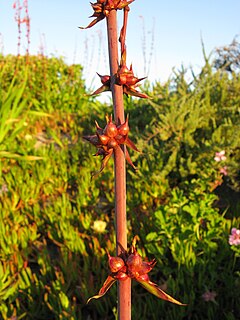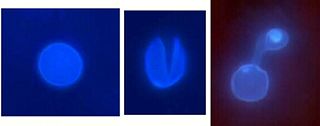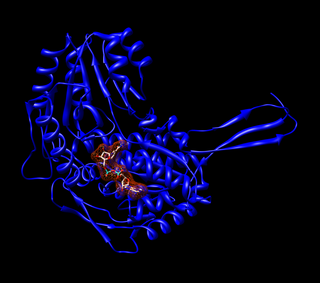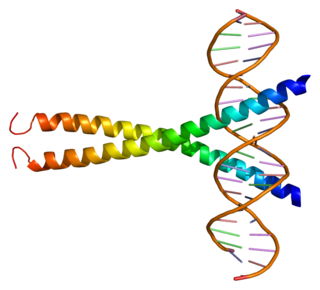
A circadian rhythm, or circadian cycle, is a natural, internal process that regulates the sleep–wake cycle and repeats roughly every 24 hours. It can refer to any process that originates within an organism and responds to the environment. These 24-hour rhythms are driven by a circadian clock, and they have been widely observed in plants, animals, fungi, and cyanobacteria.

In biology and genetics, the germline is the population of a multicellular organism's cells that pass on their genetic material to the progeny (offspring). In other words, they are the cells that form the egg, sperm and the fertilised egg. They are usually differentiated to perform this function and segregated in a specific place away from other bodily cells.

Neurotrophins are a family of proteins that induce the survival, development, and function of neurons.
1-Triacontanol (n-triacontanol) is a fatty alcohol of the general formula C30H62O, also known as melissyl alcohol or myricyl alcohol. It is found in plant cuticle waxes and in beeswax. Triacontanol is a growth stimulant for many plants, most notably roses, in which it rapidly increases the number of basal breaks. 1-Triacontanol is a natural plant growth regulator. It has been widely used to enhance the yield of various crops around the world, mainly in Asia. Triacontanol has been reported to increase the growth of plants by enhancing the rates of photosynthesis, protein biosynthesis, the transport of nutrients in a plant and enzyme activity, reducing complex carbohydrates among many other purposes. The fatty alcohol appears to increase the physiological efficiency of plant cells and boost the potential of the cells responsible for the growth and maturity of a plant.

A germline mutation, or germinal mutation, is any detectable variation within germ cells. Mutations in these cells are the only mutations that can be passed on to offspring, when either a mutated sperm or oocyte come together to form a zygote. After this fertilization event occurs, germ cells divide rapidly to produce all of the cells in the body, causing this mutation to be present in every somatic and germline cell in the offspring; this is also known as a constitutional mutation. Germline mutation is distinct from somatic mutation.

Nerve growth factor (NGF) is a neurotrophic factor and neuropeptide primarily involved in the regulation of growth, maintenance, proliferation, and survival of certain target neurons. It is perhaps the prototypical growth factor, in that it was one of the first to be described. Since it was first isolated by Nobel Laureates Rita Levi-Montalcini and Stanley Cohen in 1956, numerous biological processes involving NGF have been identified, two of them being the survival of pancreatic beta cells and the regulation of the immune system.

An appressorium is a specialized cell typical of many fungal plant pathogens that is used to infect host plants. It is a flattened, hyphal "pressing" organ, from which a minute infection peg grows and enters the host, using turgor pressure capable of punching through even Mylar.

Aldehyde dehydrogenases are a group of enzymes that catalyse the oxidation of aldehydes. They convert aldehydes to carboxylic acids. The oxygen comes from a water molecule. To date, nineteen ALDH genes have been identified within the human genome. These genes participate in a wide variety of biological processes including the detoxification of exogenously and endogenously generated aldehydes.
The endocannabinoid system (ECS) is a biological system composed of endocannabinoids, which are endogenous lipid-based retrograde neurotransmitters that bind to cannabinoid receptors (CBRs), and cannabinoid receptor proteins that are expressed throughout the vertebrate central nervous system and peripheral nervous system. The endocannabinoid system remains under preliminary research, but may be involved in regulating physiological and cognitive processes, including fertility, pregnancy, pre- and postnatal development, various activity of immune system, appetite, pain-sensation, mood, and memory, and in mediating the pharmacological effects of cannabis. The ECS plays an important role in multiple aspects of neural functions, including the control of movement and motor coordination, learning and memory, emotion and motivation, addictive-like behavior and pain modulation, among others.

Tropomyosin receptor kinase A (TrkA), also known as high affinity nerve growth factor receptor, neurotrophic tyrosine kinase receptor type 1, or TRK1-transforming tyrosine kinase protein is a protein that in humans is encoded by the NTRK1 gene.

The p75 neurotrophin receptor (p75NTR) was first identified in 1973 as the low-affinity nerve growth factor receptor (LNGFR) before discovery that p75NTR bound other neurotrophins equally well as Nerve growth factor. p75NTR is a neurotrophic factor receptor. Neurotrophic factor receptors bind Neurotrophins including Nerve growth factor, Neurotrophin-3, Brain-derived neurotrophic factor, and Neurotrophin-4. All neurotrophins bind to p75NTR. This also includes the immature pro-neurotrophin forms. Neurotrophic factor receptors, including p75NTR, are responsible for ensuring a proper density to target ratio of developing neurons, refining broader maps in development into precise connections. p75NTR is involved in pathways that promote neuronal survival and neuronal death.
Epicuticular wax is a coating of wax covering the outer surface of the plant cuticle in land plants. It may form a whitish film or bloom on leaves, fruits and other plant organs. Chemically, it consists of hydrophobic organic compounds, mainly straight-chain aliphatic hydrocarbons with or without a variety of substituted functional groups. The main functions of the epicuticular wax are to decrease surface wetting and moisture loss. Other functions include reflection of ultraviolet light, assisting in the formation of an ultrahydrophobic and self-cleaning surface and acting as an anti-climb surface.

Wheat germ oil is extracted from the germ of the wheat kernel, which makes up only 2.5% by weight of the kernel Wheat germ oil is particularly high in octacosanol - a 28-carbon long-chain saturated primary alcohol found in a number of different vegetable waxes. Octacosanol has been studied as an exercise- and physical performance-enhancing agent. Very long chain fatty alcohols obtained from plant waxes and beeswax have been reported to lower plasma cholesterol in humans. Wheat germ oil is also very high in vitamin E (255 mg/100g), and has the highest content of vitamin E of any food that has not undergone prior preparation or vitamin fortification. As a cooking oil, wheat germ oil is strongly flavored, expensive and easily perishable. Wheat germ oil contains the following fatty acids:

A plant cuticle is a protecting film covering the epidermis of leaves, young shoots and other aerial plant organs without periderm. It consists of lipid and hydrocarbon polymers impregnated with wax, and is synthesized exclusively by the epidermal cells.

Germ-free organisms are multi-cellular organisms that have no microorganisms living in or on them. Such organisms are raised using various methods to control their exposure to viral, bacterial or parasitic agents. When known microbiota are introduced to a germ-free organism, it usually is referred to as a gnotobiotic organism, however technically speaking, germ-free organisms are also gnotobiotic because the status of their microbial community is known. Due to lacking a microbiome, many germ-free organisms exhibit health deficits such as defects in the immune system and difficulties with energy acquisition. Typically germ-free organisms are used in the study of a microbiome where careful control of outside contaminants is required.

Ursolic acid, is a pentacyclic triterpenoid identified in the epicuticular waxes of apples as early as 1920 and widely found in the peels of fruits, as well as in herbs and spices like rosemary and thyme.

cAMP responsive element modulator is a protein that in humans is encoded by the CREM gene, and it belongs to the cAMP-responsive element binding protein family. It has multiple isoforms, which act either as repressors or activators. CREB family is important for in regulating transcription in response to various stresses, metabolic and developmental signals. CREM transcription factors also play an important role in many physiological systems, such as cardiac function, circadian rhythms, locomotion and spermatogenesis.
Behavioral epigenetics is the field of study examining the role of epigenetics in shaping animal behaviour. It seeks to explain how nurture shapes nature, where nature refers to biological heredity and nurture refers to virtually everything that occurs during the life-span. Behavioral epigenetics attempts to provide a framework for understanding how the expression of genes is influenced by experiences and the environment to produce individual differences in behaviour, cognition, personality, and mental health.
Ferroptosis is a type of programmed cell death dependent on iron and characterized by the accumulation of lipid peroxides, and is genetically and biochemically distinct from other forms of regulated cell death such as apoptosis. Ferroptosis is initiated by the failure of the glutathione-dependent antioxidant defenses, resulting in unchecked lipid peroxidation and eventual cell death. Lipophilic antioxidants and iron chelators can prevent ferroptotic cell death. Although the connection between iron and lipid peroxidation has been appreciated for years, it was not until 2012 that Brent Stockwell and Scott J. Dixon coined the term ferroptosis and described several of its key features.

The gut–brain axis is the biochemical signaling that takes place between the gastrointestinal tract and the central nervous system (CNS). The term "gut–brain axis" is occasionally used to refer to the role of the gut flora in the interplay as well, whereas the term "microbiota–gut–brainaxis" explicitly includes the role of gut flora in the biochemical signaling events that take place between the GI tract and CNS.














